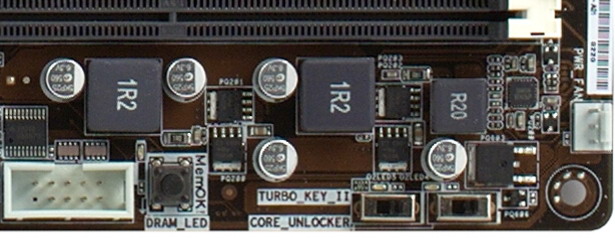ASUS M4A89GTD Pro/USB3 Motherboard
|
We reviewed a lot of motherboards based on the AMD 890GX chipset. Most were original, for example, MSI 890GXM-G65 was one of the most feature-rich mATX boards available, ECS A890GXM-A offered most peripheral functionality, finally, Gigabyte GA-890GPA-UD3H provided the most convenient way to build a CrossFire rig. Now let's see what ASUS M4A89GTD Pro/USB3 can offer.
Design
ASUS M4A89GTD Pro/USB3 also has double space between graphics slots to provide better ventilation for dual-slot graphics cards. But if you only have one card, mind that only the second graphics slot has all 16 lanes. That's where the graphics card should be installed. The first slot needs to be plugged up with a special switch card. Otherwise, both graphics slots will work as x8.

We're not quite sure why ASUS had to resort to such a solution, because the AMD 890GX chipset allows configuring slots automatically from BIOS, as was proven by motherboards from other makers. In terms of practical use, flexibility is needed so you can decide what's more important for you. If you need as many free PCIe slots as possible, using the suggested second graphics slot will be more reasonable. But if it's about PCI cards, the first graphics slot would've come in handy. Of course, if you have an inexpensive or a mid-end graphics card, both x8 and x16 PCI Express 2.0 lanes will be sufficient, but it's nice to be sure you're using hardware capabilities to the max.
In all other aspects, the layout of ASUS M4A89GTD Pro/USB3 is only good. The manufacturer clearly made an effort so that both users and builders were comfortable. Power connectors are located along the edges, and the ATX12V one is higher than usual so that the nearby heatsink doesn't make it difficult to connect cables.
Four fan connectors are quite enough for a motherboard of this class. Also note the PCIe x4 port for high-speed expansion cards.
Another original feature is mechanical switches to automatically overclock and unlock the cores of relevant CPUs. In particular, triple-core processors based on quad-core dies and the coming quad-core CPUs on the Zosma core (a hexacore die with two cores disabled). These modes can also be enabled in BIOS, though.
Write a comment below. No registration needed!
|
|
 |
|
|
|


